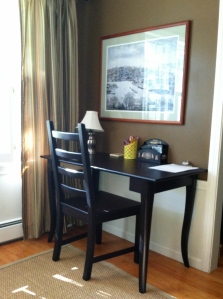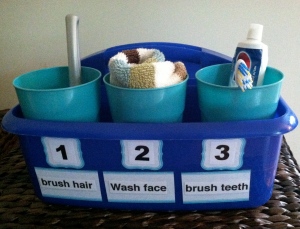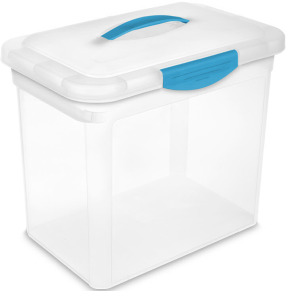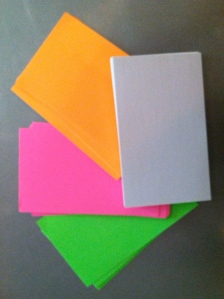You are currently browsing the tag archive for the ‘explosive’ tag.
 Now that the kids are back in school and getting into the new routine, this can be a great time to experiment with homework spots. When our sensory kids are younger, homework is often done close by parents as a way for us to help them with work but also to help them stay on task and facilitate breaks when frustration is building. As kids get older, many parents often assume that the next logical step is having kids do homework alone in their bedrooms. But for many rigid, anxious, or distracted kids, this is often too big of a step. Bedrooms are filled with distractions and if never used as a work space before, that can be a big cognitive shift for our sensory kids around the use of this space.
Now that the kids are back in school and getting into the new routine, this can be a great time to experiment with homework spots. When our sensory kids are younger, homework is often done close by parents as a way for us to help them with work but also to help them stay on task and facilitate breaks when frustration is building. As kids get older, many parents often assume that the next logical step is having kids do homework alone in their bedrooms. But for many rigid, anxious, or distracted kids, this is often too big of a step. Bedrooms are filled with distractions and if never used as a work space before, that can be a big cognitive shift for our sensory kids around the use of this space.
This is where the middle space comes in – a space that is not the kitchen and not the bedroom but a new, dedicated work space that provides some separation and independence. Often, this is a process we can make bigger then it is. But alas, you only need a few simple things for a Just-Right Homework Spot:
– An unused corner. Pick a corner in your home that is in a room next to the kitchen area (where most of us parents are while the kids do homework). The less visual distractions in the space, the better (no direct windows, limited wall hangings etc.). The corner we chose was just holding a storage ottoman before and was not adding any functional support to the room – just right for a homework spot.
– A simple desk. Here – less is more. A simple, open writing desk works well in a corner (no drawers, open lines helps minimize distraction and visually lightens the corner). The one here is the LEKSVIK Desk from IKEA – http://www.ikea.com/us/en/catalog/products/80133402/
– A simple chair. Hold off on wheels and spinning chairs until you see how the space works. The chair is always something you can always change or add sensory supports to as time goes on. The chair here is the KAUSTBY Dining Chair from IKEA -http://www.ikea.com/us/en/catalog/products/10242838/. few examples of simple sensory supports you can add to the chair down the road include:
1) A disk seat for movement – here’s one from Waccess on Amazon.com – http://amzn.to/1AuSX1C
2) A bouncy band for feet movement – Bouncy Bands on Amazon.com http://www.amazon.com/Bouncy-Bands-students-without-distracting/dp/B00KRTNH0O .
– A Clean, Open Desktop – the key to a productive work space for many sensory kids it keeping the visual desktop space clean. On the desktop, just keep it to writing utensils, a desk light, and a homework plan. Having a supply bin close-by and accessible. Which brings us to….
– A Portable Homework Bin – in order to keep supplies close-by and accessible (but off the desk), get a portable bin to hold all homework supplies. One I like is the Sterilite Large Showoff Storage Container – http://www.sterilite.com/SelectProduct.html?id=25&ProductCategory=248§ion=1
Before your child is knee deep in homework, experiment with finding a simple, distraction free homework spot for your chid. A new, somewhat separate homework spot supports independence and self-reliance. A middle step as you help your sensory child make space for life ~
 A big part of supporting the Back-to-School transition has nothing to do with school — it happens in the many transitions at home around preparing for school. The morning transition can be one of the more challenging transitions as many of our rigid, anxious, or distracted kids have a hard time waking up in the morning, have anxiety about school in general, and/or know they will be working hard to pay attention and hold it together for the next 6 hours. Our goal is to make their mornings easier so they have more energy and willpower for the experiences where they will need it at school.
A big part of supporting the Back-to-School transition has nothing to do with school — it happens in the many transitions at home around preparing for school. The morning transition can be one of the more challenging transitions as many of our rigid, anxious, or distracted kids have a hard time waking up in the morning, have anxiety about school in general, and/or know they will be working hard to pay attention and hold it together for the next 6 hours. Our goal is to make their mornings easier so they have more energy and willpower for the experiences where they will need it at school.
THE DRESSING STATION
One way we can support a structured, simplified morning is to create a Dressing Station. This allows us to break the dressing task into 2 steps:
1) Evening Step: Pick out and put clothes in the dressing station the night before (this simplifies the morning and also helps our sensory kids begin the cognitive shift to school coming the next day).
2) Morning Step: In the morning, go to dressing area and get dressed.
A dressing area supports many rigid, anxious, or distracted behaviors.
– It helps our rigid child simplify a transition to an undesired task (school!).
– It helps our anxious child create a routine which will help calm and support their transition to something that might feel overwhelming (school!).
– It helps our distracted child stay on task with a simplified, visual plan to complete a task.
WHY THIS WORKS
– It does the first step (and often hardest step for many sensory kids) of gathering supplies into one area and sequencing the task.
– We’ve broken down the task into manageable pieces.
– We’ve created a visual checklist of sorts with the 1,2,3 Labels / Picture Images.
– It can grow with your kids. As they get older, you can remove the visual supports. You can transition from images to numbers 1,2,3 and then to no visual supports besides the hooks or the chair.
THREE TYPES OF DRESSING STATIONS
* A 1,2,3 Bin System:
This works well for younger kids learning to dress and can be portable!
* A Hook System:
Can use with images, numbers or just have your child hang each item of clothing separately in order. A bag on a hook can hold socks / shoes.
* A Chair Station:
You can use duck tape to mark sections on the chair, have a basket under the chair to hold shoes and socks, or just pile everything on the chair (sometimes too much structure is just too much!).
*** For kids who might need to tap into the Power of Choice to stay regulated with this task, think about having 2 Dressing Stations – A Hook System and A Chair Station. If they are having a hard time doing step one (picking out clothes the night before), you can give them a choice of which dressing station to use – this might help get them over the hump.
SUPPLIES
– Bins for the 1,2,3 Bin System. These bins in this example are from Ikea – http://www.ikea.com/us/en/catalog/products/20163265/
– Row of Hooks – Can attach to a wall (make sure your hang at the right height for easy access to hooks and images / numbers) or if you child is tall enough, you can use Over-the-Door row of hooks. A Row of Hooks with 3 or 4 hooks works best. Here’s an example from Lowe’s – http://low.es/1mlueGC
– Picture Images: Take your own pictures of your real life tasks, pictures from magazines, stock photos, or image software like Boardmaker – http://www.mayer-johnson.com/boardmaker-software/ , Picture Exchange Communication System – http://www.pecsusa.com/ , or Do 2 Learn (can sign-up for an annual membership on Do 2 Learn!) – http://www.do2learn.com/
– A Chair: One that has a design of “hook” corners or a flat top is best – 1) undergarments on seat of chair, 2) top on Left side of chair, 3) bottom on Right side of chair, and 4) shoes and socks under chair.
– Labels: Adhesive labels for a 1,2,3 visual support if needed.
– Small Binder Clips to attach labels to Bins.
– Optional: Laminating Machine to protect picture images.
Break it down, eliminate distracting stimuli, and create a visual support or a system. Try one of these easy Dressing Stations for a smoother morning transition. Sensory Organizing = Making Space for Life ~



 A big part of supporting the Back-to-School transition has nothing to do with school — it happens in the many transitions at home around preparing for school. It happens in the morning as our kids get ready for the day at school and/or in the afternoon / eventing as our kids prepare for the next day at school. These many transitions and tasks at home are also where small changes and simple supports can be a powerful tool for our sensory kids.
A big part of supporting the Back-to-School transition has nothing to do with school — it happens in the many transitions at home around preparing for school. It happens in the morning as our kids get ready for the day at school and/or in the afternoon / eventing as our kids prepare for the next day at school. These many transitions and tasks at home are also where small changes and simple supports can be a powerful tool for our sensory kids.
The morning transition can be one of the more challenging transitions as many of our rigid, anxious, or distracted kids have a hard time waking up in the morning, have anxiety about school in general, and/or know they will be working hard to pay attention and hold in together for the next 6 hours. Our goal is to make their mornings easier so they have more energy and willpower for the experiences where they will need it at school.
Supporting Morning Bathroom Routines
Knowing that our kids are working through a challenging transition, let’s use our core Sensory Organizing tools and break it down, eliminate distractions, and create a visual guide.
The Bathroom Caddy
Supplies
– A Simplified bathroom routine – only include what has to be done in the morning.
– A Caddy (that can get wet!). This one is from Lakeshore Learning but they can be found at any home store.
– 3 Plastic Cups to help separate and categorize the tasks. These came in a package of 3 from Walmart. Just make sure they fit snugly in the caddy
– Labels to number the tasks in order and to spell out task in simple terms. I found mine at Staples from Martha Stewart Home Office with Avery.
– Clear packing tape to put over labels to protect from water.
– For extra support, you could add a laminated Morning Routine Checklist and hang it on the wall or mirror in the bathroom.
***Put in the order that make sense for your child not what makes sense to you. If they like to wash their face before they brush their teeth, so be it.
Why This Works
– It does the first step (and often hardest step for many sensory kids) of sequencing the task so they know where and how to start.
– We’ve broken down the task into 3 manageable pieces.
– We’ve batched the supplies needed in the order which will help our sensory kids stay on task.
– We’ve created a visual checklist of sorts with the 1,2,3 Labels.
– We’ve made it portable. If our child if having a more challenging morning and we need to change locations or need to give them a choice in what sink they use to do their bathroom routine, this allows us to do that.
Start now with simple this morning support. Practice and adjust as needed so you know what works best for your sensory child. Small Changes for more Peaceful School Mornings ~
 Feelings can be such an abstract concept for many of our kids. Our sensory kids are full of passion but sensory feelings can come on strong and change quickly often leaving our rigid, anxious, or distracted kids feeling overwhelmed and struggling to make connections between cause and effect. Just like we can provide external, visual supports with organizing their environment, we can provide external, visual supports to help them identify and organize their feelings.
Feelings can be such an abstract concept for many of our kids. Our sensory kids are full of passion but sensory feelings can come on strong and change quickly often leaving our rigid, anxious, or distracted kids feeling overwhelmed and struggling to make connections between cause and effect. Just like we can provide external, visual supports with organizing their environment, we can provide external, visual supports to help them identify and organize their feelings.
Like many other Sensory Organizing supports, the first step is often the most important and needs to be visual. Since feelings can seem all-encompassing without a clean beginning and end, we need a visual to help them make some space to notice and observe when a new feeling might have come in. By helping them notice, without judgement, we can often help them begin the process of making connections. Then we can provide some options to help them work through the feelings with a tangible plan that can include identifying feeling triggers and talking through different strategies for the next experience.
Here’s an example of a Connecting Feelings Visual:
SUPPLIES:
* Compassion and Understanding
* Paper
* Markers
* Picture Images (take your own pictures of your real life tasks, pictures from magazines, stock photos, or image software like Boardmaker – http://www.mayer-johnson.com/boardmaker-software/ , Picture Exchange Communication System – http://www.pecsusa.com/ , or Do 2 Learn (can sign-up for an annual membership on Do 2 Learn!) – http://www.do2learn.com/. The images used here are from Boardmaker.
Strong feelings are one of the main ways sensory kids communicate with us. By creating a simple visual to help them make space between themselves and their feelings, we can teach them to observe, identify, and ultimately advocate for their feelings and needs. This is Sensory Organizing and true empowerment. Simple changes for more peaceful days ~
 One of the highlights of Summer is travel – trips to see family, check out new places, and try new things. Often, these are also things that can be challenging for many sensory kids. Thankfully, by bringing a few extra supports on the road, we can often soften the new or overwhelming experiences. One easy way to support sensory kids on the road is to bring along a easy-to-make, easy-to-adjust Travel Schedule.
One of the highlights of Summer is travel – trips to see family, check out new places, and try new things. Often, these are also things that can be challenging for many sensory kids. Thankfully, by bringing a few extra supports on the road, we can often soften the new or overwhelming experiences. One easy way to support sensory kids on the road is to bring along a easy-to-make, easy-to-adjust Travel Schedule.
Here’s a simple and portable Travel Schedule:
SUPPLIES:
* Identify the experiences / times of day you think might need some extra support – challenging routines or new experiences and focus on those top 2-3 few times to support with visual schedule. For a child that needs less support, this can be used for a broader, full day schedule. Be sure to mix in some fun pictures that highlight favorite people you might see on the trip and/or fascinations.
* A Small 4×6 Photo Book – you can find these at Home Stores (Target, Walmart, Home Goods), Craft Stores, or on Amazon.com
* 4×6 Index Cards – come in white or colored.
* Picture Images (take your own pictures of your real life tasks, pictures from magazines, stock photos, or image software like Boardmaker – http://www.mayer-johnson.com/boardmaker-software/ , Picture Exchange Communication System – http://www.pecsusa.com/ , or Do 2 Learn (can sign-up for an annual membership on Do 2 Learn!) – http://www.do2learn.com/ . You can also get pamphlets or brochures of places you will be visiting and put pieces of those into the visual schedule.
* Black marker to label index cards
* Tape to attach images to index cards.
* Create one image index card that represents a “New or Special” Activity. This can be your universal sign that something new / unexpected is coming. A visual prompt can give sensory kids time to internally prepare.
Take a few moments each morning to set-up the photo book to support key experiences in the upcoming day. The index cards can be moved in / out of plastic photo protectors very easily and allow you to set a chronological / ordered schedule and adjust as needed. By supporting a few challenging times, you give your sensory child (and your family) the opportunity to have more moments of real connection and joy. And connection and joy is what vacation is really all about.
Simple changes for more peaceful summer days ~








